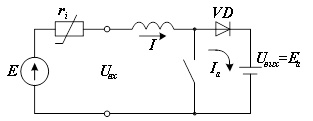Regulatory Features of Solar Battery Charger
Main Article Content
Abstract
The aim of the work is the analyze the of regulation characteristics of a switching voltage regulator of the step-up type. The case when the regulator's power source is a solar battery and the load is a rechargeable battery is considered. It is noted that in this mode, the switching voltage regulator operates in the mode of regulation of the output current (battery charging current).
The case when the battery voltage is equal to the maximum no-load voltage of the solar battery is analyzed. It is shown that in this case regulation characteristic of the input current of the switching regulator coincide with the output characteristics of the solar battery, in which the axis of voltage is replaced by the axis of the relative open-time of the key of the switching regulator. Taking into account the received input regulation characteristics, the output regulation characteristics of the switching regulation were built.
If the battery voltage is less than the maximum no-load voltage of the solar battery, the regulation characteristics of the switching regulation will coincide with a limited section of the output characteristics of the solar battery. In this case, the correspondence between the voltage scale and the scale of the relative open time of the key of the switching regulator will depend on the ratio between the battery voltage and the maximum no-load voltage of the solar battery. The conditions, under which the maximum amount of electrical energy will be obtain from the solar battery at different levels of illumination were analyzed. The condition, under which the inductance of the switching regulator will receive a discontinuous current mode were analyzed. For different levels of illumination of the solar battery, as well as depending on the magnitude of the inductance, the critical value of the relative open-time time of the key of the switching regulator, at which a discontinuous current mode occurs in the inductance were determined. Taking into account the possibility of the occurrence of such a mode, the adjustment of the previously obtained regulation characteristics were carried out. The normalized graphs of the regulation characteristics for the input and output current of the switching regulator, taking into account the possibility of the occurrence of a discontinuous current inductance in it are given. Recommendations on the expediency of using various sections of these characteristics, when charging batteries from a solar battery, are given. The dependence of the amount of under-received electrical energy from the solar battery, which is related to the pulsating nature of the input current of the switching regulator and the selected battery voltage value is analyzed. Recommendations regarding the choice of the battery voltage for a solar cell of the selected type are given.
Article Details

This work is licensed under a Creative Commons Attribution 4.0 International License.
Authors who publish with this journal agree to the following terms:- Authors retain copyright and grant the journal right of first publication with the work simultaneously licensed under a Creative Commons Attribution License that allows others to share the work with an acknowledgement of the work's authorship and initial publication in this journal.
- Authors are able to enter into separate, additional contractual arrangements for the non-exclusive distribution of the journal's published version of the work (e.g., post it to an institutional repository or publish it in a book), with an acknowledgement of its initial publication in this journal.
- Authors are permitted and encouraged to post their work online (e.g., in institutional repositories or on their website) prior to and during the submission process, as it can lead to productive exchanges, as well as earlier and greater citation of published work (See The Effect of Open Access).
References
I. N. Haq. et al., "Development of battery management system for cell monitoring and protection" International Conference on Electrical Engineering and Computer Science (ICEECS), Kuta, 2014, pp. 203-208. DOI: 10.1109/ICEECS.2014.7045246.
E. M. Krieger, C. B. Arnold "Effects of undercharge and internal loss on the rate dependence of battery charge storage efficiency" Journal of Power Sources Vol. 210, 2012, pp. 286-291. DOI: 10.1016/j. jpowsour. 2012.03.029
Thomas B. Reddy and David Linden, Eds., "Linden’s handbook of batteries" 4th ed., McGraw-Hill Companies, Inc. 2011, ISBN: 978-0-07-162419-0 1457 p. URL: http://dl.booktolearn.com/ebooks2/engineering/electrical/9780071624213_lindens_handbook_of_batteries.pdf
Arash Shafiei, Ahmadreza Momeni and Sheldon S. Williamson “A Novel Photovoltaic Maximum Power Point Tracker for Battery Charging Applications”, 25th IEEE Canadian Conference on Electrical and Computer Engineering (CCECE), Montreal, QC, Canada, 2012, DOI: 10.1109/CCECE.2012.6335050
José M. N. Vieira, Alexandre Manuel Mota "Implementation of a stand-alone photovoltaic lighting system with MPPT battery charging and LED current control" IEEE International Conference on Control, 2010 pp. 185-190. DOI: 10.1109/CCA.2010.5611257
Khaehintung N., Pramotung K., Sirisuk P. "RISC microcontroller built-in fuzzy logic controller for maximum power point tracking in solar-powered battery charger" Proceedings of IEEE TENCON 2004 Conference, 2004. DOI: 10.1109/TENCON.2004.1415013.
V. Y., Romashko, L. M., Batrak "Osoblyvosti rezhymu roboty uz·hodzhuvalʹnoho impulsnoho rehulyatora, shcho pratsyuye na akumulyator [Features of the switching regulator operation оn a rechargeable battery]," Microsystems, Electronics and Acoustics 2018, № 4, Т. 23, pp. 22 - 30. DOI: 10.20535/2523-4455.2018.23.4.131272.
Y. P. Goncharov, O. V. Budonny, V. G. Morozov, M. V Panasenko, V. Y. Romashko, V. S. Rudenko, Peretovyuvalna technicala. Navchalnyi posibnyk. Chastyna 2 [Power conversion equipment. Tехt book. Part 2]., Kharkiv: Folіo, 2000. ISBN 966-03-0697-0.
Masoum M.A.S., Dehbonei H. Design construction and testing of a voltage-based maximum power point tracker (VMPPT) for small satellite power supply Proceedings of 13th annual AIAA/USU Conference on Small Satellites, 1999 URL: http://citeseerx.ist.psu.edu/viewdoc/download.
Salas V., Olías A. Barrado A., Lázaro A. Review of the maximum power point tracking alg orithms for stand-alone photovoltaic systems Solar Energy Materials and Solar Cells Vol. 90, Issue 11, 6 July 2006, pp. 1555-1578. DOI: 10.1016/j.solmat.2005.10.023.
Romashko, V. J.; Verbitsky, I. V.; Kyrychіk, I. I. «Analiz vtrat energii v sistemi vidboru maksimalnoi potuzhnosti sonyachnoi batarei [Energy loses analyze in solar battery maximum power picking system]» Tekhnichna elektrodynamika, No 4, pp. 55-57, 2014. URL: http://techned.org.ua/2014_4/st18.pdf.





